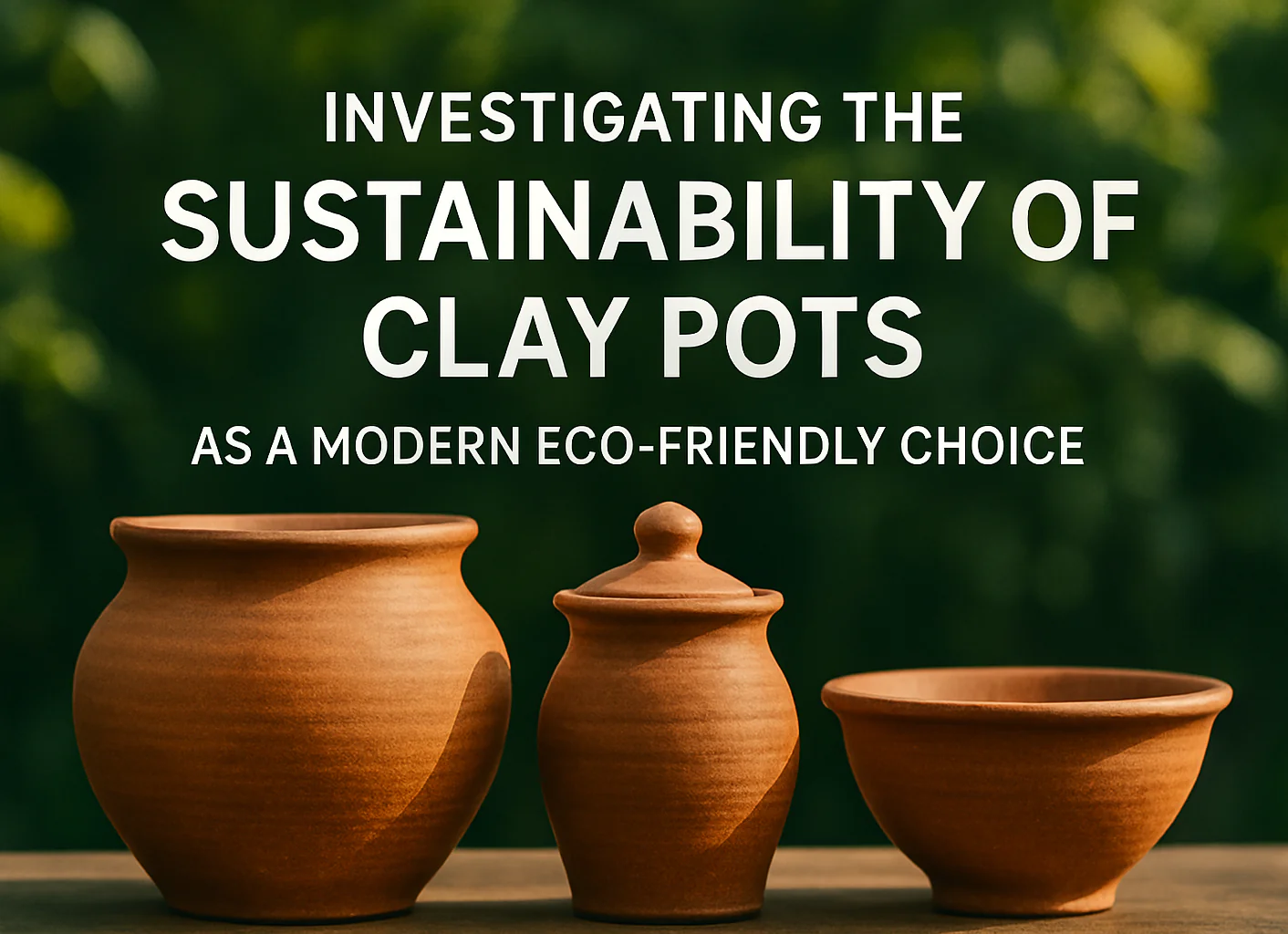As pieces of decor, clay pots have decorations home and gardens for centuries. People have valued clay pots for their charming, rustic looking and natural feeling. But, in our modern world, the question of how sustainable is clay pots has begun to float. This guide will help us understand the sculpturing of clay pots by looking at the environment the materials are sourced from, looking at the processes involved, the life span, obsolescence, and all the processes in between. This is to help people understand the reason clay pots are considered as one of the most eco-friendly gardening and decoration choices.
Table of Contents
1. Understanding Clay Pots: Their Makeup and Source
Clay pots are made from natural clay and its minerals. The production chain begins with:
Extraction of clay from river beds and quarries.
Purification on kiln and removal of extra impurities and clay moisture.
Molding which can be done through devices such as wheels and molds or done manually.
Firing in kilns which is done at 800 to 1200 degrees centigrade.
Clay is an ideal raw material because it is non-toxic and sustainably abundant. Additionally, it does not require petroleum-based feedstocks or synthetic alternatives, and unlike synthetic alternatives, does not require extensive chemical processing.
2. Comparing Environmental Footprints
While examining how sustainable is clay pots, it is necessary to measure its environmental impact against common alternatives:
| Material | Raw Material Origin | Energy for Production | End-of-Life Impact |
|---|---|---|---|
| Clay Pots | Natural clay, local quarries | Moderate kiln firing energy | Biodegradable / recyclable |
| Plastic Pots | Petroleum derivatives | Low molding energy | Persistent waste, non-biodegradable |
| Fiberglass | Petroleum + glass fibers | High energy for fiber production | Hard to recycle, landfilling |
| Metal (Steel) | Iron ore mining | High melting & refining energy | Recyclable but energy-intensive |
Raw materials: The location of clay is often closer to the end-user, thus reducing transportation emissions.
Manufacturing energy: It is true that firing a kiln consumes gas or electricity, but it is a modern kiln that optimizes efficiency.
Waste and pollution: Compared to the firing of clay, the production of plastics is far more toxic. The firing of clay is a relatively clean process, while the production of plastics can emit volatile organic compounds (VOCs).
3. Longevity and Reusability
A product’s lifespan is important in terms of sustainablity. Clay pots have:
Enduring Quality: When fired and glazed appropriately, clay pots will endure the test of time in terms of cracking both indoors and outdoors, having the potential to last several decades.
Lasting Beauty: Unlike trend-based plastics, clay is not prone to becoming shrunken and brittle as time carries on. It retains both its beauty and strength.
Repairable: Unlike most items, pots can be fixed with natural ductile materials, and even be reused as fragments in new containers.
Choosing a clay pot helps you lessen the need for short-lived pots, therefore you help in reduction of waste.
4. Clay Pots and Life Cycle Assessment
A basic life cycle assessment (LCA) considers the following.
Raw materials: Mining and extraction of materials has non-destructive effects and low to zero harsh chemicals.
Manufacturing: Uses energy for available hot water, water for shaping and cooling.
Distribution: Distance of purchase and local supply can cause a rise in fuel. Pots produced locally lessen this concern.
Active Use: Through passive water regulation , irrigation becomes minimal.
After Use: Without glaze, the clay is both biodegradable and wholly recyclable , able to be ground into grog, or crushed for new ceramics.
In conclusion, the sustainability of clay pottery is overall positive with consideration to the optimization of transport and production.
5. Energy and Emissions: Analyzing the Impact of Kilns
The most energy-demanding process is still the kiln firing. It is, however, partially offset by several factors:
Energy Sources: The majority of potteries now have kilns powered by renewable sources or have gas burners.
Batch Processing: It is more advantageous to fire several pots at the same time and the energy cost gets shared, improving the energy efficiency with respect to the number of pots.
Heat Recovery: Cutting-edge kilns can re-use the exhaust heat for preheating the incoming air or for drying greenware.
Choosing sustainable kiln technology vendors helps further in the reduction of carbon footprint for the clay pots.
6. The Use of Water and Other Resources
In the clay pot two distinct functions are associated with water: molding and cleaning. Examples of sustainable practices are:
Closed-loop water systems: Reusing the water to shape and wash helps limit the amount of fresh water required.
Rainwater Harvesting: The collected rainwater is used for cleaning the clay residue.
Minimal Chemical Additives: The natural clay does not require a lot of chemical treatments, thus helping reduce water pollution.
All the above mentioned practices help enhance the sustainability of clay pots and help in the conservation of fresh water.
7. The Functions of Glazes and Finishing Techniques
Unlike most pots that are decorated with glazes for aesthetic reasons and to retain water, terracotta pots are unglazed and allow moisture to escape. When evaluating glazes, one should consider:
Natural vs. synthetic: Pick glazes containing no synthetic materials and are made of natural minerals that are free of lead and heavy metals.
Low-temperature glazes: Using lower-temperature fires reduce energy usage, making the glazing process more environmentally friendly.
Local sourcing: Glazes made near the base of the pottery are far more eco-friendly than those transported from afar, thereby reducing long distance shipping emissions.
Ensuring that your clay pots are finished with eco-friendly materials makes them sustainable from the inside out.
8. Soil Health and Plant Benefits
Clay pots are eco-friendly and provide the following sustainable benefits to gardening:
Porosity: Assists in the circulation of air and minimizes the chances of root rot, thus reducing the stress plants experience and the need for chemical intervention.
Temperature regulation: Thick walls of clay pots buffer delicate roots from rapid temperature shifts.
Microbial habitat: Beneficial soil microbes that enhance nutrient cycling thrive unharmed in unglazed clay.
Eco-friendly clay pots improve plant health, decreasing the need for fertilizers or fungicides.
9. Local Artisanship and Community Support
Purchasing pots from local potteries reduces the environmental impact while also enhancing economic sustainability:
Fair wages and craftsmanship: Provides reliable earnings to artisans, allowing them to sustain their traditional skill.
Community resilience: Local production enables money generated to be retained within communities thereby strengthening local economies.
Cultural heritage: Specific regional techniques reflect the diversity and history of the people.
By shopping from sustainable clay pot makers, you support positive social and environmental change.
10. Upcycling and Recycling
Even the most long-lasting clay pots have a shelf life and will eventually need to be replaced. Fortunately, the processes that are offered at the end of life are simple, such as the following:
Grog: Shatter aged pots and mix the coarse particulate into new clay to increase firing strength.
Gardening: Place coarse clay remnants as drainage at the bottom of pots or as soil moisture retention mulch.
Art: Incorporate dish remnants into mosaics, stepping stones, or lawn ornament borders.
Such upcycling techniques will ensure there is no waste produced within the clay pot life cycles.
11. Miscellaneous Challenges/Considerations
While generally sustainability focused, there are other practices that are somewhat overlooked, such as:
Weight of the product. Shipping of distance will be more costly and put a larger footprint if items are sent a long distance because they are heavier.
Breakage hazard. Increased likelihood of the item shattering during transport or handling.
Moisture retention: Extremely wet climates may lead to porous pots requiring more water, contributing to overwatering.
Local artisans will remedy all the above in combination with selected pot sizes and feet for aging durability.
12. Green Innovations in the Production of Clay Pots
The industry is advancing with more environmentally friendly changes:
Solar-powered kilns: These make use of solar thermal energy to fire ceramics.
Bio-based binders: Plant-based binders are replacing synthetic additives.
3D clay printing: This method of clay printing minimizes waste by extruding only the exact amount of clay needed.
These innovations further address how sustainable clay pots are as environmentally friendly options.
13. Advice for Sustainability for the Consumer
To further promote sustainability while using clay pots:
Buy second-hand: Vintage pots, while often overlooked, are still fully serviceable.
Inspect quality: Pots with thicker walls and more uniform firing are less prone to breakage.
Pair with saucers: These help prevent water runoff stains and extend the life of clay pots.
Seasonal care: Pots should be kept indoors when temperatures drop to freezing to avoid cracking.
By following these simple steps, these actions encourage a sustainable gardening practice while maximizing the environmental benefits.
14. Conclusion: The Adoption of Clay Pots in Our Ecological Perspective
In regards to sustainability, clay pots are a clear winner. When responsibly sourced and manufactured with efficient energy use, and reused or recycled in a practical manner, clay pots are remarkably eco-friendly. They aid in healthier flora, decrease dependence on petrochemicals, and support the local economy. Opting for clay pots instead of plastic or synthetic alternatives makes a positive environmental impact, one pot at a time.
By embracing and celebrating the aesthetics of clay, the users of clay pots will join millions of gardeners and decorators who are committed to environmental stewardship.




